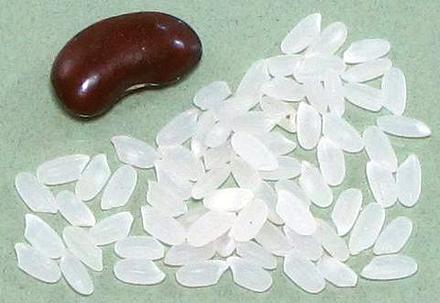 [Sushi Rice; Uruchimai (Japanese - ordinary rice); Orzo sativa
var japonica]
[Sushi Rice; Uruchimai (Japanese - ordinary rice); Orzo sativa
var japonica]
Japonica type rice is a short or medium grain rice with translucent grains high in easily gelatinized amylopectin starch. This is the preferred type for cooking in Japan, Korea and parts of northern China. Major reasons are that it can be handled easily with chopsticks, and that Japonica can be grown in cooler climates than Indica (long grain) can.
Japonica is also used in the Caribbean and South America, where it may be imported from California or locally grown. Despite what you see on the Internet, this is the rice to use for Arroz con Pollo, which is related to Spanish paella. Paella is always made with japonica rice.Japanese cultivars are a little different from California cultivars. The Japanese are short grain and the California is medium grain. Most popular in Japan is Koshihikari, a recently developed cultivar, but Akitakomachi is well liked. Sasanishiki is preferred for sushi, and Yamada Nishiki is used to make sake.
About 85% of the California crop is Japonica. The original Calrose (USDA # C.I. 8988), released in 1948, was developed by Japanese farmers to be compatible with Japanese tastes and California growing conditions. The original 8988 was replaced by more water thrifty varieties in the 1970s and "Calrose" is now a generic term for California varieties. I personally much prefer Kukuho Rose, grown in California by Koda Farms. California's major export markets are Japan, Korea, Taiwan and Turkey, in that order. Less than 60% of the California crop is consumed in North America. Calrose rice is also grown in Australia.
Some Japanese Koshihikari rice is now grown in California. Some brown California rice is produced, mainly for sale in North America as Asians eat almost no brown rice, though it may be used in tea. Some short grain "sweet rice" (Japanese mochigome) is grown in California, particularly by Koda Farms, and it is also grown elsewhere in the United States, but this is a specialty rice used for sweets and deserts. Only in Laos and northeastern Thailand is sweet rice the main rice. Caution: for Thai and Laotian recipes you must use Thai sweet rice, which is a long grain sweet rice.
General Information on Rice
Japanese Rice.
All Japanese and Korean restaurants and sushi bars in North America use California rice. It is also used for Eastern European cabbage rolls and other stuffing uses, including Grape Leaf Dolma rolls. It is imperfectly adaptable to Italian Risotto and Spanish Paella. For those uses exact absorption characteristics are critical.
Japonica rice is little used in southern China (depends on fashion of the time), and is not used at all in India or Southeast Asia. For northern India use Basmati, and for southern India use local varieties, or Thai Jasmine, if local varieties aren't available. For Southeast Asia, including Indonesia and the Philippines, use Thai Jasmine rice.
Japanese imports are very hard to find and absurdly expensive. California grown Japanese cultivars are often packaged to look ever so Japanese, except for the "Product of USA" in small print on the back side. If the price looks almost acceptable, be suspicious, if what you want is "real Japanese".